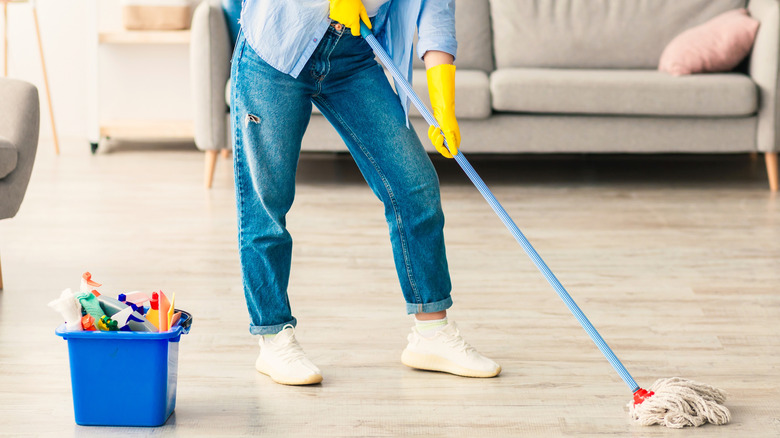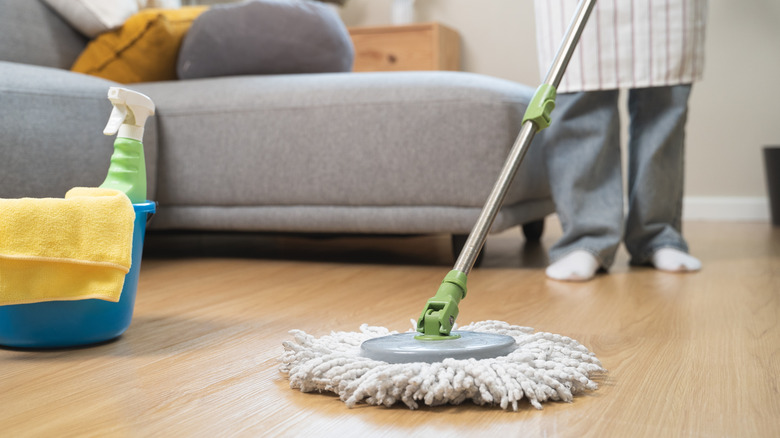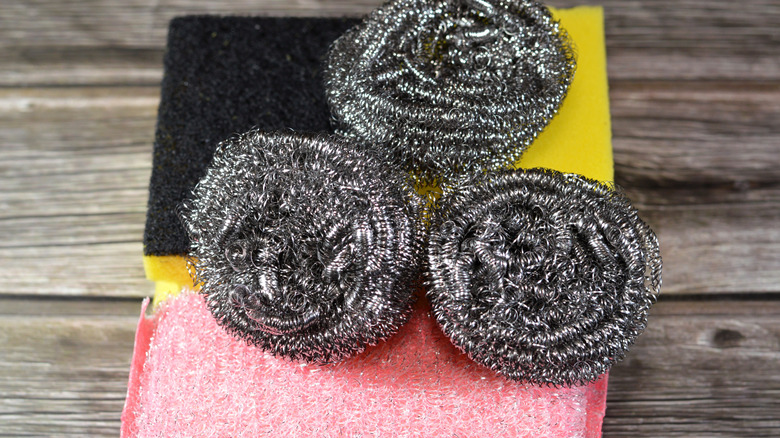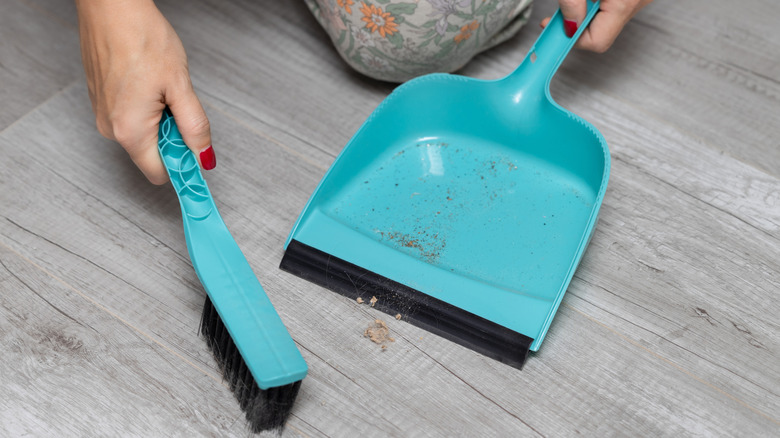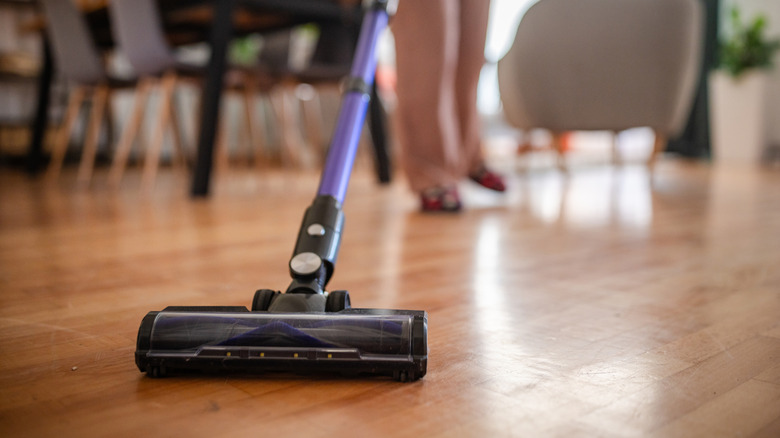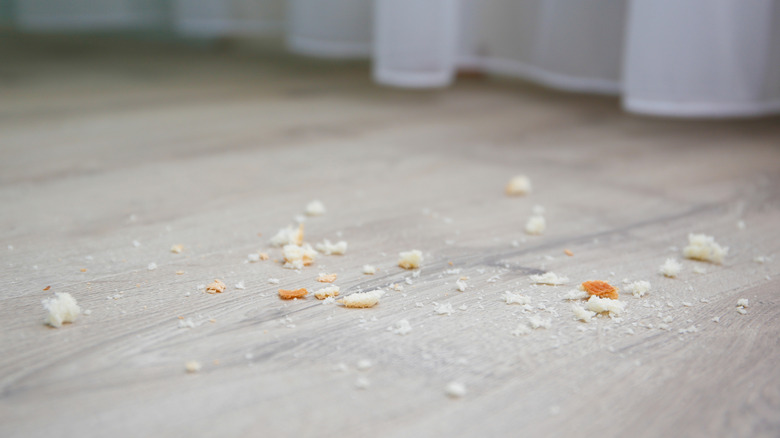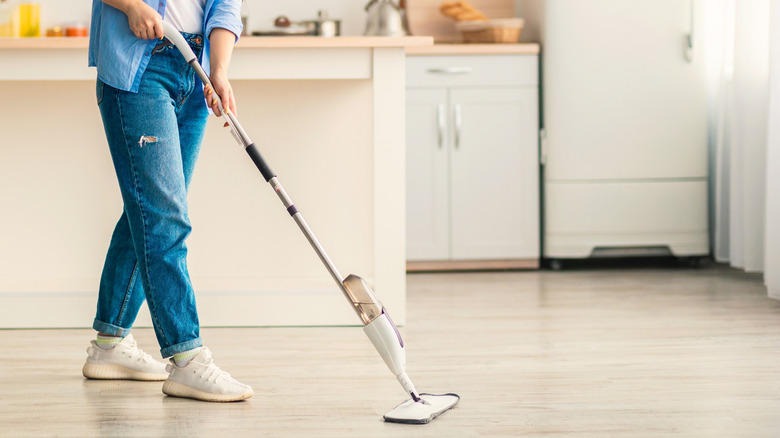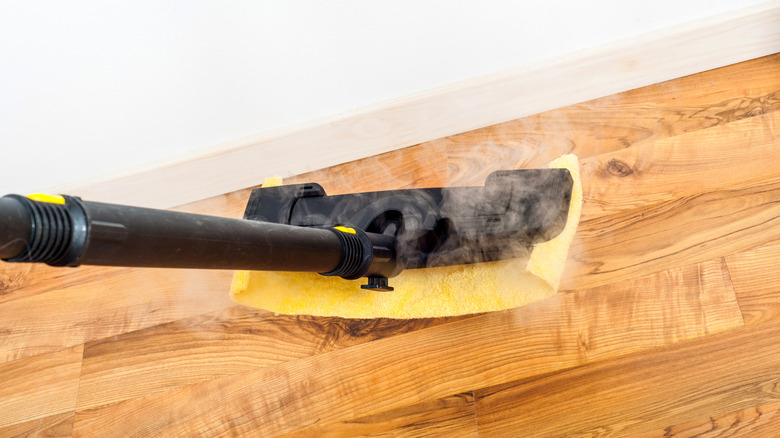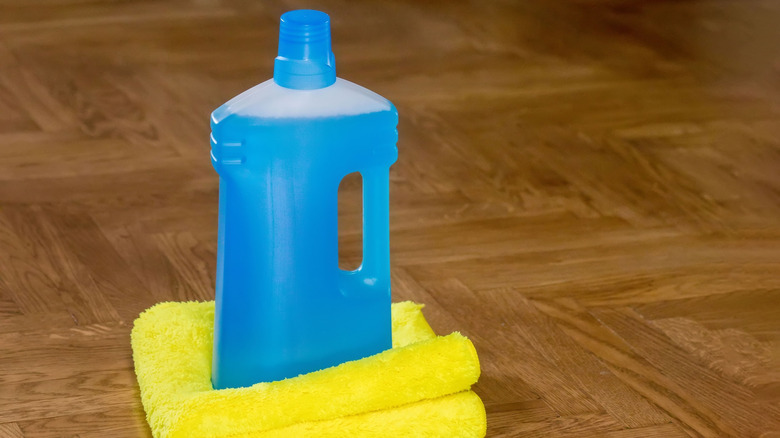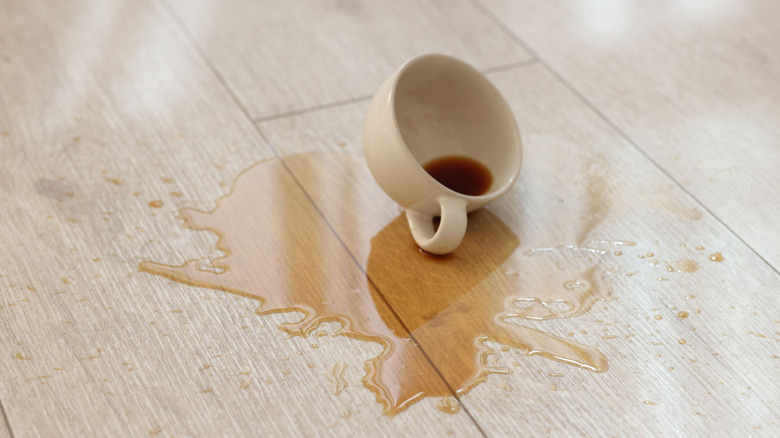Mistakes Everyone Makes When Cleaning Laminate Floors
We may receive a commission on purchases made from links.
Laminate floors have been a popular choice for many years. In addition to being relatively affordable, durable, and easy to install, many homeowners choose laminate because it's effortless to clean. Unfortunately, some people hear "easy-to-clean" and assume that anything will go. While cleaning laminate floors is not overly complex, there are some mistakes you'll want to avoid.
There is a best way to clean every type of flooring in your home without causing damage. And laminate is no exception. If not cleaned properly, your floors may lift or warp, develop scratches and stains, or appear dull and unappealing. Ahead, we'll take a look at the common mistakes people make when cleaning laminate. You'll learn to sidestep mishaps and what you should do instead to keep your floor clean while protecting and ensuring they look their best for years to come.
Using the wrong type of mop
There are so many different types of mops on the market, including string, sponge, and microfiber. It would be a mistake to assume you can use whichever type you already have at home. String mops, in particular, are not a good fit for your laminate floors. As you know, to use a string mop, you dip it in a bucket of water. Even if you wring it out, all those little strings or strips on the mop head will still hold on to a decent amount of water. Water is the enemy of your laminate — moisture can get in the cracks between the floorboards, potentially causing them to lift or warp.
To avoid this potential damage, it is key to know the difference between the best and worst mops for laminate floors. While string options aren't recommended, spray mops with a microfiber head are generally seen as the best choice. Switching to one of these, such as the O-Cedar ProMist Max Microfiber Spray Mop, is one of the best tips to prevent your laminate floors from lifting or warping. The microfiber head doesn't hold as much water as a string mop. You'll use minimal liquid when spraying as opposed to lifting the mop out of a bucket of water.
Scrubbing with steel wool or other abrasive cleaning tools
As you're mopping your laminate floors, you might come across a particularly sticky spot or a stubborn stain. It may be tempting to grab steel wool or a stiff-bristled brush to loosen the gunk or remove the stain. However, doing so is a mistake that could damage your floors. Steel wool, stiff brushes, and other abrasive cleaning tools should never be used to clean laminate. They can scratch the planks, leaving unsightly nicks and marks that could also become spots to trap more dust and dirt. Moreover, these abrasive cleaning tools can also strip away the protective coating on the floor. This could make it more difficult to clean in the future and give it a duller-looking finish.
Instead of cleaning your laminate with abrasive tools, it is important to stick with approved materials, such as microfiber, sponges, or soft rags. You may need to exert a little more elbow grease to loosen stuck-on gunk. But the reward of protecting your flooring and extending its lifespan should be well worth the additional effort.
Not sweeping in the direction of the planks
Do you know that how you sweep your laminate floors matters? Well, it does. Sweeping the wrong way can actually make the surface more challenging to clean. As you know, laminate floors feature rectangular planks that are joined together. Because of this design, there are long seams along the planks where they meet. If your sweeping process involves moving your broom sideways across the planks, you could push dirt and dust between them. The dirt will get trapped in the seams, leaving your floor dirty or giving you an extra challenging cleaning task to attempt.
Instead, the best way to sweep laminate floors is to follow the direction of the planks. Another sweeping tip: When using a broom on your laminate floor, make sure that it has soft, not stiff, bristles. As mentioned above, anything too stiff could inadvertently scratch the floor and leave new openings to trap even more dirt.
Failing to turn off the brush roll when vacuuming
Vacuuming your floors isn't always a mistake — but it can be if you're not careful. Many vacuums feature an integrated brush roll. Sometimes called the beater bar, this component is designed to remove more dirt and debris from carpeting. The roller, which is covered with several small bristles, spins. As the bristles rub against the carpet fibers, they loosen and pull up debris, allowing the vacuum to suck them up. While this component of a vacuum cleaner is helpful when cleaning carpeting, it shouldn't be used on laminate. Beyond being unnecessary (laminate does not have long fibers that can trap debris like carpet), the brush roll can also damage the floor. All of those rotating bristles can scratch the surface and, again, leave more openings for dirt to get trapped.
To avoid this mistake, it is crucial to turn off the brush roll before running a vacuum over the laminate planks. If your vacuum doesn't have the option to disable the brush roll, you shouldn't use it on the floors. Stick with sweeping or dry mopping or, if preferred, invest in a new vacuum that offers the option to turn off the brush roll. Some models even feature interchangeable cleaning heads, specifically those designed for laminate and other hard surface types. You might want to consider one of these models, like the Kenmore 600 Series Bagged Canister Vacuum w/ Pet PowerMate, if you want to purchase a new vacuum.
Going long periods without vacuuming or sweeping
It's so easy to get caught up with everything going on at work, home, or school. Before you know it, a couple of weeks have passed, and you haven't had the chance to bring out the broom or vacuum (with the beater bar turned off). However, neglecting your laminate floors for too long without sweeping or vacuuming can be a mistake. Beyond the dust and dirt you're leaving in your house to potentially trigger asthma or allergies, you're also threatening the appearance and longevity of your surfaces. Dirt, tracked-in sand, and debris can have sharp edges. As they are pushed or rubbed across the floor when someone walks across it, those sharp edges could end up scratching the surface. These scratches can offer a place to trap more dirt and can make your floor look dull and dingy.
The best way to avoid this potential damage is to keep up with the basic cleaning task of sweeping or vacuuming the planks. Establishing a daily cleaning routine is ideal, especially for those high-traffic areas. But if this is a bit too much for your schedule, aim to sweep or vacuum at least once per week, if not two to three times. You can also reduce the amount of dirt and debris that enter your home in the first place by placing door mats outside of each entrance.
Mopping too frequently
If your goal is to keep a clean home, you may be tempted to mop your laminate floors once every week or oftener. However, this frequency of wet mopping isn't recommended for laminate. Remember, too much water can damage the laminate material, which is made from wood. Even if you're only using a damp microfiber spray mop, you're still introducing moisture to the material. If you do this too frequently, the chances of the planks warping or lifting will only increase.
Instead, it is generally recommended to deep clean a laminate floor with a wet mop (using a microfiber mop that won't drop excessive amounts of water) only once every few weeks. This will limit the amount of moisture you're exposing the wood to and minimize the chances of any water-related damage. Use a dry mop, like the O-Cedar Dual-Action Microfiber Sweet Dust Mop, between deep cleaning sessions. This can help make sure that too much dust and debris isn't building up on the surface.
Using steam mops for a deeper clean
Steam mops are wonderful cleaning tools. They make it possible to remove grease, grime, and other gunk using clean, natural steam. However, while they have many benefits, there are also some dangerous downsides to using a steam cleaner, which can be harmful to laminate floors. As you likely know, hot steam is essentially water vapor. This will leave the planks damp as it settles on them, and some moisture will make its way into the gaps.
As mentioned above, moisture is very problematic for laminate, and it can cause the boards to warp or lift. The layers of each plank could separate if they're exposed to too much moisture. This is because the hot steam and moisture might loosen the glue that keeps these layers stuck together.
So, you're much better off saving your steam cleaner for tile floors, showers, sinks, stoves, and other safe surfaces. When your laminate needs a deeper clean, reach for your spray mop. Other times, stick with dry cleaning methods, such as sweeping, dry mopping, or vacuuming (with the brush roll disabled).
Choosing the wrong cleaning solution
There are several cleaning products to avoid using on laminate. If you make the mistake of choosing one of these "forbidden" products, you could cause permanent damage to the planks. Many people like to clean with bleach because of its ability to kill germs and viruses and sanitize surfaces. However, attempting to clean your laminate floors with bleach will be a mistake. Bleach is too strong; it has the potential to damage or remove the finish, leaving it dull-looking and making cleaning even more of a challenge. Similarly, you should not use any oil-based cleaning products. While these cleaners are good for wood flooring and furniture, they aren't meant for laminate. They may leave behind stains and streaks that you won't easily eliminate.
While you can find commercially available cleaning solutions for the laminate planks in your home (such as the Bona Multi-Surface Floor Cleaner Spray or the pet-friendly ProCare Floor Cleaner), you can also easily make a safe and effective cleaning solution to use with your spray mop. You'll only need two ingredients, which you likely have in your kitchen or laundry room: water and distilled white vinegar. Combine the ingredients in a spray bottle. For each cup of water, you'll want to mix in about 1.5 tablespoons of vinegar.
Not addressing spills and stains right away
Don't make the mistake of leaving spills and stains unaddressed. The longer they sit on the surface of the plank, the more likely they are to cause lasting damage. Spills of water and other liquids can be especially detrimental to the floorboards. Remember, you want to avoid water as much as possible with laminate; small and big spills can seep between the planks. This could cause a whole host of problems, including warping, lifting, buckling, and swelling. Spills also have the potential to stain or discolor your floorboards. The longer the mess sits on the floor, the more likely it is that lasting discoloration will occur.
To avoid a discolored, warped, or otherwise damaged laminate floor, act quickly to clean up spills as soon as they occur. Consider keeping some microfiber cloths — such as the Homexcel Microfiber Cleaning Cloths — in a convenient location. They are absorbent, so they'll help you wipe the excess moisture. If any stain is left behind after cleaning up a spill, you'll want to eliminate it right away before it sets in. For some blemishes, you can use the aforementioned vinegar and water solution. If the stain is caused by something oily, such as ink, carefully blot it with nail polish remover.
Waxing the floors
Waxing wood floors helps protect them against damage and restores their finish. So, you should also apply wax when looking for the best ways to bring old laminate floors back to life and keep them looking their best, right? Wrong. Waxing laminate is a pretty big mistake you'll want to avoid. Applying wax can damage the laminate. The substance may harm the upper protective layer of the planks, making them more susceptible to other damage and giving them an overall dull finish.
Moreover, wax is certainly not the simple secret to streak-free laminate floors. Because it won't be absorbed as it would when applied to hardwood, the top layer of the planks will have a sticky residue. Dust, dirt, pet hair, and other junk can get trapped in the sticky layer. Your home's floor surfaces will look dirty faster and be more challenging to clean because of the stickiness covering them.
Instead, save the waxing for any hardwood surfaces in your home. Stick to the regular cleaning schedule with sweeping, vacuuming, dry mopping, and the occasional spray mopping to protect and maintain your floors. If you're worried about the flooring getting scratched, consider using area rugs and felt furniture pads — such as the X-Protector Premium Felt Pads — on the bottom of your chairs and tables.
